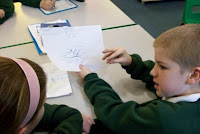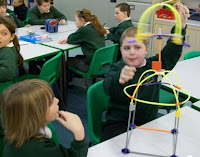 A couple of weeks ago I posted some thoughts and starting points as we began working together on texts that explain processes how they work and how they are presented. This is something we have found students can find challenging, not describing the process but the aspect of the work that requires the use of passive voice, a commentary on action without personal involvement. The text type can very easily change from one to another depending on the use of pronoun for example
A couple of weeks ago I posted some thoughts and starting points as we began working together on texts that explain processes how they work and how they are presented. This is something we have found students can find challenging, not describing the process but the aspect of the work that requires the use of passive voice, a commentary on action without personal involvement. The text type can very easily change from one to another depending on the use of pronoun for exampleFirst of all Wallace or we pressed the big red button, and the arm came out.. places the author in the recount domain.
First of all you press the button places the author in the domain of instructional writing,
What we were aiming for was for the students to be able to describe a process as if they were looking in on events as the device does all the work while they commentated on the action.
 Visualising and rehearsing this type of recording process is a real challenge, especially I find with youngsters who no matter how hard they try are in the middle of the experience. For this unit then we decided to use talk as the vehicle to engage with the process, and to enable the children to hear how the process sounded and from here to develop their writing skills.
Visualising and rehearsing this type of recording process is a real challenge, especially I find with youngsters who no matter how hard they try are in the middle of the experience. For this unit then we decided to use talk as the vehicle to engage with the process, and to enable the children to hear how the process sounded and from here to develop their writing skills.The unit began with the children engaging with and exploring a number of explanatory texts and providing opportunities for the children to hear the differences between
- recounts
- instructions
- and explanations
Texts that explain processes rarely exist in isolation, but are usually found as part of larger textual bodies. The texts we provided included longer textual pieces that had a process explained somewhere within in it. We were keen that these texts should not be just traditional paper based forms, and among the texts we provided was also a Video explanation about web search strategies from Commoncraft. This was an interesting tool, that really made us sit back and think. As with many such texts it opens with a general statement, but at times the tone and movement of the text meant it was tricky to distinguish between it and a set of instructions. Was the text explaining how a web search works, or providing tips on how to use a websearch more effectively. Actually it seemed to be doing both at different points. So what was it that differentiated the instructional part of the text from the explanation part. We used this video alongside other written texts to help us unpick the features that made one type of writing different from the other. This was then used to help us create a marking and review ladder to use when we began working on our own writing.
Talk for Writing: Rehearsing the Process Using Video
 To frame and practice the process of writing an explanation we began with modelled and guided talk for writing ativities based on "The Tellyscope," an Aardman's Wallace and Gromit short. We watched the video together, and then spent time talking about the device, in its context. A wild and whacky tool for controlling the TV from the comfort of an arm chair. Next the sound was turned off and elements of the video used to focus on the process involved in operating the device, before in talking twos the students were encouraged to describe the sequence of events to each other. The process was played again and the children tried to commentate on what they could see happening, matching their commentary to onscreen action. At this point we also began to introduce the use of passive pronouns such as it, and the addition of time connectives to act as sentence openers and to extend the ways we could describe and link sections of the sentence to include causal connectives,
To frame and practice the process of writing an explanation we began with modelled and guided talk for writing ativities based on "The Tellyscope," an Aardman's Wallace and Gromit short. We watched the video together, and then spent time talking about the device, in its context. A wild and whacky tool for controlling the TV from the comfort of an arm chair. Next the sound was turned off and elements of the video used to focus on the process involved in operating the device, before in talking twos the students were encouraged to describe the sequence of events to each other. The process was played again and the children tried to commentate on what they could see happening, matching their commentary to onscreen action. At this point we also began to introduce the use of passive pronouns such as it, and the addition of time connectives to act as sentence openers and to extend the ways we could describe and link sections of the sentence to include causal connectives,
eg. A big red button is pressed which causes the arm of the chair to open. A ball is placed in the hand and pulling this back results in a spring being squashed down.
After rehearsing and engaging with the explanation in this way, the children were provided with flow charts containing frame captures from the film, that showed significant points in the process. The children worked in pairs following modelled writes and building on their their oral work to describe the stages in the process. Key to these tasks were choice of sentence openers and how they would join pairs of sentences that described cause and effect.
 Having described the process the children were then encouraged to work together to create a short generalised opening statement for the explanation, saying what the device was for and who might find it useful, and to write their own headings for their written piece. The children also used computer based versions of the writing frames to re-present edit and improve their work against our success criteria.
Having described the process the children were then encouraged to work together to create a short generalised opening statement for the explanation, saying what the device was for and who might find it useful, and to write their own headings for their written piece. The children also used computer based versions of the writing frames to re-present edit and improve their work against our success criteria.Independent Have A Gos
With the guided and modelled part of the process completed and our marking ladders and rubrics developed, we watched together another Walace and Gromit short, The Snooze-a-tron, we had chosen to be our big write focus and stimulus.
This marvellous machine designed for the discerning chomper of cheese lulls its user to sleep by fluffing pillows and tucking in with ted, before the long suffering pooch becomes integrated within a sheep counting machine that will carry him off to the land of nod. As a home learning challenge the children were asked to design their own "snooze-a-tron" or "wake-a-tron," that they would use to frame an explanation text of their own.
 The children responded marvellously to this, bringing in models, diagrams and sketches. Some students had begun to rename the suggested devices. I had a particular fondness for the machine known as the "Alarm Cluck," the name conjured up all sorts of ideas even before I found out how it actually worked. Again this series of sessions began with the students talking about their devices, explaining how they worked to their friends and rehearsing how and where they might use particular text features. Throughout the post are a few examples of the students engaged in this process. All that was left now was for the students to put into practice what they had been learning as a result of these activities.
The children responded marvellously to this, bringing in models, diagrams and sketches. Some students had begun to rename the suggested devices. I had a particular fondness for the machine known as the "Alarm Cluck," the name conjured up all sorts of ideas even before I found out how it actually worked. Again this series of sessions began with the students talking about their devices, explaining how they worked to their friends and rehearsing how and where they might use particular text features. Throughout the post are a few examples of the students engaged in this process. All that was left now was for the students to put into practice what they had been learning as a result of these activities.During this unit of work a number of ICT tools were used to support first of all, the talk for writing process and also the student's presentation of written outcomes. These were developed from a series of Collect, Store, Prepare and Share activities.
- The Common Craft and Wallace and Gromit videos were downloaded from You Tube to allow use of them in school.
- The Wallace and Grommit videos were downloaded as MP4 files using the "get You Tube Video" bookmarklet mentioned in this previous post.
- The MP4 files were opened in Quick Time Pro, enabling frame captures to be made. These images from the movie were used in the development of table top talk and writing frames, as well as in the making of IWB notebooks to help with sequencing and ordering.
- Talk for writing frames were also made available on the school network so that students could use these to present their explanations, and facilitate further discussion and review of their texts.
- Within the talk process children were also encouraged to use Podium as an audio recording device to help them present and hear as a reader the texts that they had been authoring.
3 comments:
One of the really great things about your post is that is so detailed that others can follow what you did exactly.
You have started me off thinking about how cause and effect are shown through film/images adn I'm off to explore.
Thanks
Thanks Joy really glad you found the post useful.
As an NQT really struggling with getting the children to understand the concept of an explanation text, I found this really useful! Lots of them are using what they know about instruction texts and trying to relate it to that but your suggestion of using 'it' should really help. Many thanks!
Post a Comment